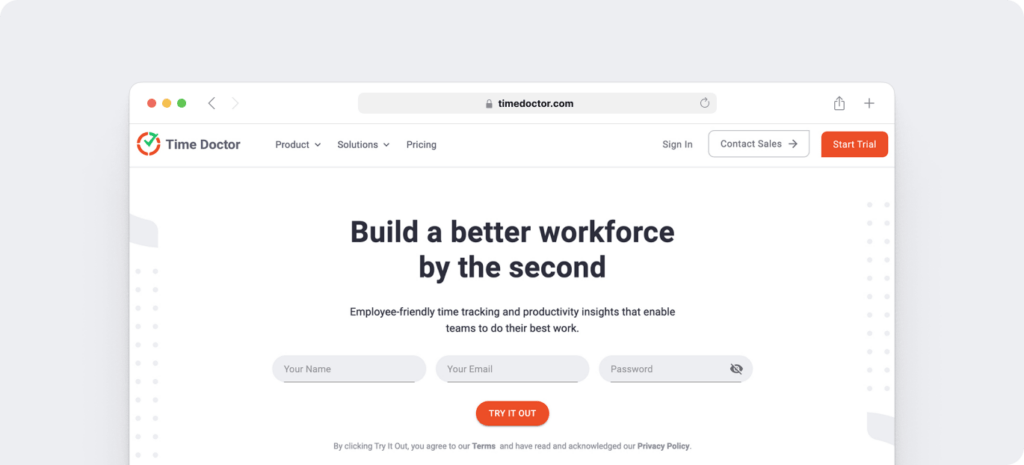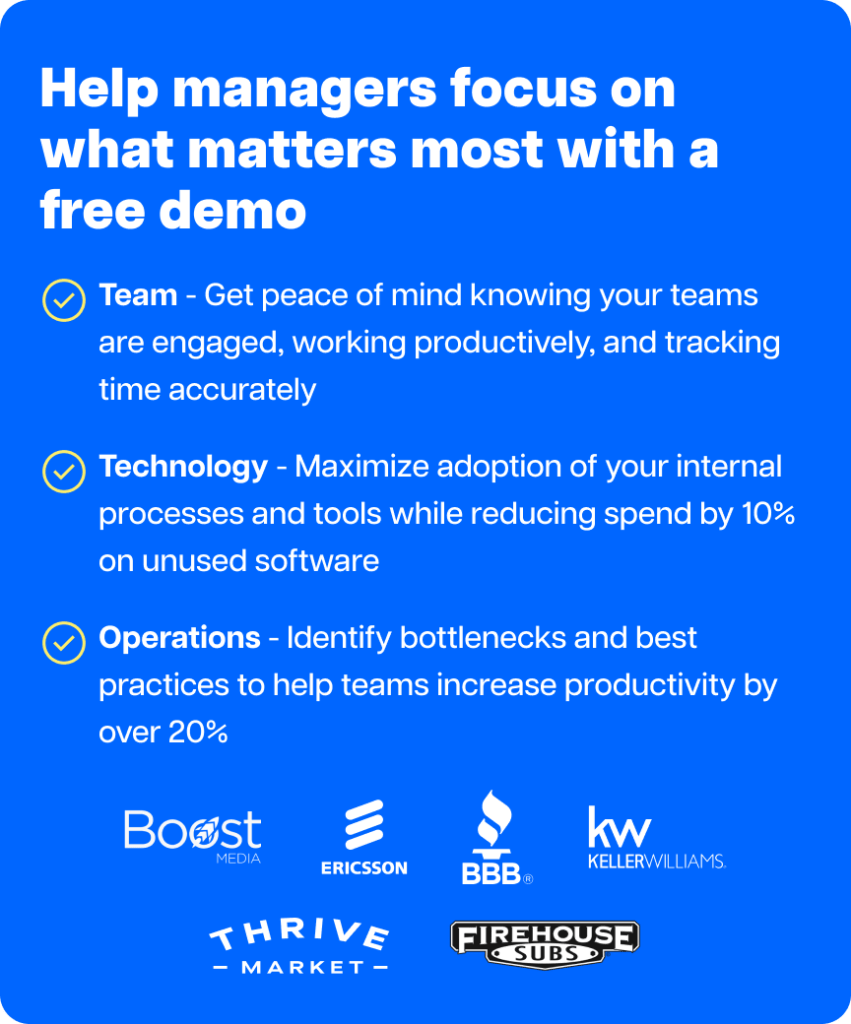Want to learn how to measure employee productivity in the IT industry?
It’s no secret that measuring employee productivity is one of the hardest things to do these days. As there are so many variables to keep track of, determining how well an employee is performing can be a very confusing process for most businesses.
And when you’re dealing with the IT sector, this can become even more challenging!
But don’t worry.
In this article, we’ll first go over why traditional productivity tracking is flawed – especially when it comes to the IT industry. We’ll then go over a few different approaches to accurately measure employee productivity in the IT industry.

Table of Contents
- Why do you need to measure employee productivity?
- Why traditional productivity monitoring is flawed
- How to measure employee productivity in the IT industry accurately
Let’s get started.
Why do you need to measure employee productivity?
Before we go into why traditional productivity monitoring is flawed and the ways to solve it, let’s first cover why you need to track employee productivity in the first place:
- Identify strengths and weaknesses: By assessing productivity, you can identify high-performing employees and areas where individuals or teams excel. This information helps in recognizing strengths and areas that need improvement.
- Optimize resource allocation: Understanding productivity levels enables better allocation of resources. You can ensure that the right amount of workforce is allocated to tasks and projects, avoiding underutilization or overburdening.
- Enhance performance: Productivity measurement provides data that can be used to implement performance improvement strategies. This can include training programs, process improvements, or providing additional support where needed.
- Set and achieve goals: Clear productivity metrics help in setting realistic and achievable goals. It allows for tracking progress towards these goals and making necessary adjustments to stay on track.
- Boost employee morale: Recognizing and rewarding productive employees can boost morale and motivation. Employees who see their efforts acknowledged are more likely to stay engaged and committed.
- Improve decision-making: Data-driven insights from productivity measurements assist managers in making informed decisions regarding hiring, promotions, and workflow adjustments.
- Increase efficiency: Identifying inefficiencies through productivity analysis allows for process optimization, reducing wasted time and resources, and improving overall efficiency.
- Ensure fair compensation: Productivity data can help in determining fair compensation and rewards. It ensures that employees are compensated based on their contributions and performance.
- Monitor remote work: With the rise of remote work, measuring productivity becomes essential to ensure that employees are maintaining their performance levels outside the traditional office environment.
- Drive business growth: Ultimately, high productivity contributes to the overall growth and success of the business. It leads to increased output, better customer satisfaction, and higher profitability.
By measuring employee productivity, organizations can create a more effective, efficient, and motivated workforce, leading to sustained business success.
Why traditional productivity monitoring is flawed
One of the reasons why productivity tracking is so difficult for most businesses is that they take the wrong approach to it.
In most cases, people look at workforce productivity through this productivity formula:

Here, productivity is seen as a measure of the ratio of how much was produced (employee output) over a set period of time and effort (input).
Here’s why this is a problem when measuring productivity:
1. It doesn’t focus on quality
Traditional productivity measurement only focuses on the quantity of output an employee churns out. It doesn’t measure the quality of that output.
This is especially problematic in the IT service industry as when your IT team is responding to tickets, they need to solve them accurately to truly satisfy the customers.
Your team could theoretically breeze through all their IT support requests without really solving any issues. By traditional performance measurement, they would be super-productive as they covered tons of tickets and their total output is high.
However, as they aren’t providing high quality service and haven’t actually solved anything, they shouldn’t be seen as productive at all!
2. It doesn’t take the type of task into account
This is another key issue with traditional productivity tracking.
When measuring efficiency purely based on output, you assume that all tasks were of equal difficulty and equal importance.
However, we all know that that isn’t true.
Here’s an example to show you what we mean:
Let’s say you have two IT professionals – X & Y.
X is in charge of responding to service requests and Y is in charge of website maintenance.
Responding to a simple IT service request is probably not as important or as difficult as redoing your website’s security infrastructure.
However, as X can answer a number of calls and solve tons of service requests in the number of hours it takes Y to redo your security infrastructure, they’ll automatically be seen as having higher productivity than Y.
Doesn’t seem fair, right?
3. It doesn’t look at intangibles
Another issue with traditional productivity monitoring is that it only monitors tangible outputs – omitting the various intangibles that employees are involved with every day.
What are these intangibles?
While there are hundreds of intangibles out there, here are a few common ones:
- Employee engagement
- Teamwork
- Compassion
- Dedication
- Respect
- Gratitude
Why are they important?
While they may not directly connect with an employee’s output, these intangibles play a huge role in measuring productivity at your organization. That’s why failing to account for these can lead to a severely flawed productivity measurement system at the individual level.
For example, let’s say one of your IT support members is excellent at dealing with customer complaints. However, they’re not a team player and alienate the other team members in the work environment. According to traditional performance measurement, you can’t fault them as their output is excellent.
However, as they’re horrible at teamwork and their engagement level is poor, the rest of your team could be suffering – leading to diminished business and team productivity overall.
How to measure employee productivity in the IT industry accurately
Now that you know why traditional productivity measurement is flawed, let’s get into how you can accurately measure the productivity of your IT staff:

1. Measure employee performance metrics
One of the best ways to measure productivity is by using KPIs (key performance indicators) as a performance metric.
What is a KPI?
They’re performance measurements over various activities that you can use to determine how well your employees are doing.
For example, “no. of sales closed” is a good performance metric for a salesperson. This way, when you’re evaluating their productivity, you can look at this KPI to determine their productivity levels.
As these employee performance metrics are hard data, it takes some of the subjectivity out of performance measurement to ensure that things remain accurate. Also, sometimes a performance metric can test for both quantity and quality of output in addition to taking the type of task into account.
Additionally, as employees are made aware of what performance metrics they’ll be judged on, they can focus their efforts on ensuring that they get the best results. This takes away a lot of the ambiguity that’s often associated with productivity measurement.
However, it’s important to remember that while metrics bring a lot of transparency to the measurement process, it’s hard to measure intangibles with them. That’s one of the reasons why employee performance metrics should just be a part of your productivity analysis process.
Here are some performance metrics that you can use to measure your labor productivity:
A. Actual IT spend vs planned
This is a good metric to compare what you expected to spend on your IT department vs. what was actually spent over a period of time. It’s a good measure of the cost-effectiveness of your entire IT department – helping you better determine workforce productivity.
B. Average spend per IT employee
This productivity metric divides the total expenditure on your IT department by the number of employees you have. It’s an estimate of how much money you put into each employee.
Generally, the lower you have to spend per employee, the easier it is to maintain higher productivity and higher employee efficiency.
C. Average revenue per employee
This metric divides the total revenue you generate from your IT department by the number of IT team members employed. Use this figure as a benchmark when looking at the next individual productivity and performance metric:
D. Actual revenue generated
Look at each employee individually and calculate the revenue they bring in over a timeframe. Then, compare it with the average revenue per employee to determine their productivity level when compared to other team members.
E. Number of projects on time
This metric calculates the number of tasks and projects each employee submitted/handled on time. A higher score here usually indicates high individual productivity.
F. Customer satisfaction score (CSAT)
This is a great metric to evaluate the quality of the output of your IT customer service representatives. Here, you calculate the average customer satisfaction scores for each employee to determine an employee’s ability according to the customers.
In case your company uses a performance rating system, you can use that instead.
G. Average speed to answer
This metric measures how quickly your IT support staff responds to a customer request. A low average speed to answer indicates proactive project management.
2. Use self-assessments and peer reviews
Self-assessments and peer reviews are some of the best ways to measure all the aspects that performance metrics and KPIs can’t measure. Naturally, that makes it one of the best ways to measure all the intangibles that go into accurate productivity measurement.
A. Self-assessments
Here, employees are asked to evaluate their performance themselves. This is helpful as nobody is better placed to evaluate their capabilities than themselves.
Here, you ask them to compare how productive they feel they can be against how productive they actually were in various departments like teamwork, time-management, etc.
As the worker is setting target productivity gains they’re capable of themselves, they’re setting achievable individual productivity goals to pursue in the future.
And when these individual goals relate to your company goals, you’ll be able to directly link individual performance to a better bottom line!
B. Peer performance review
Since many intangibles like teamwork and empathy are closely tied to how employees interact with each other, asking an employee’s peers for insights into their overall productivity makes sense.
Additionally, as they work alongside them every day, their peers will be in a much better position to accurately evaluate an employee’s productivity.
After all, who do you think has a better picture of someone’s intangibles – a manager who only closely monitors a worker once a month, or their coworkers who spend eight hours with them everyday?
However, as remote workers don’t interact with their peers as much as an in-house team does, remote peer evaluations may not be as detailed. Another problem with peer reviews is that the measurement can be highly subjective and each employee’s biases can easily creep into their evaluations
It’s one of the reasons why you shouldn’t rely on just one peer performance review to determine how someone is doing. Look at reviews from all their peers as a whole to get a “general” idea of employee performance.
Then, couple these general observations with the productivity data you collected via your metrics to create holistic productivity measures for your business.
The easiest way to keep your employees productive
Sure, measuring worker performance is important, but just measuring productivity isn’t enough.
You need a way to actually keep employees productive too, right?
That’s where time tracking and productivity tracking software comes in.
These tools will help you:
- Keep your employees focused and achieve higher productivity on their job
- Deter them from wasting their work time
- Gain valuable, daily updates into workforce productivity
Luckily, Time Doctor is a productivity tracking software that was designed to do all this, and more!
What is Time Doctor?

Time Doctor is a powerful productivity tracking software that’s used by large companies and small businesses to easily keep track of, and boost their in-house and remote employees productivity.
With this productivity software, you’ll be able to:
- Ensure that your IT staff is actively working during their work day – even when engaged in remote work.
- Use insightful, real-time reports to analyze the overall productivity of each IT team member.
- Make sure that your IT staff is spending time on the right websites and right apps.
- Track their productivity across various platforms, like ClickUp and Zendesk.
- Accurately track worker hours and pay them for the time put in.
- Track worker productivity from anywhere using the Android app.
Note: Time Doctor only tracks worker productivity during their work hours, so you won’t have to worry about the privacy issues associated with employees being monitored during their off-time.
Wrapping up
While measuring the employee productivity in the IT industry can seem daunting, it doesn’t have to be.
Once you recognize the flaws associated with traditional productivity monitoring and implement more effective measures, you’ll have no difficulty getting accurate insights into your IT team’s productivity.
Use the metrics and techniques we mentioned here to create a productivity measurement strategy that’s both accurate and employee-friendly.

Liam Martin is a serial entrepreneur, co-founder of Time Doctor, Staff.com, and the Running Remote Conference, and author of the Wall Street Journal bestseller, “Running Remote.” He advocates for remote work and helps businesses optimize their remote teams.


